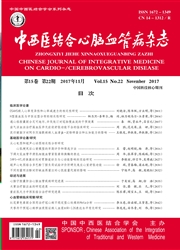

 中文摘要:
中文摘要:
目的探讨促红细胞生成素(EPO)和粒细胞集落刺激因子(G—CSF)联合治疗对创伤性脑损伤(TBI)大鼠神经功能恢复及神经细胞再生的影响。方法将125只雄性Wistar大鼠随机分成假手术对照组(Sham组)、脑创伤模型组(TBI组)、EPO治疗组(T+E组)、G—CSF治疗组(T+G组)、EPO和G.CSF联合治疗组(T+E+G组),然后再按照1、3、5、7、14d随机分为5个亚组,每个亚组5只。用Feeney法制备脑创伤模型,各治疗组大鼠均于造模后立即给予相应的干预措施,共3d。各组大鼠分别于术后1、3、5.7、14d进行神经功能缺失评分(raNSS),并处死大鼠取脑组织行5-溴脱氧尿嘧啶核苷(BrdU)单标及BrdU/神经元核抗原(NeuN)、BrdU/胶质纤维酸性蛋白(GFAP)双标免疫荧光染色检测新生增殖细胞数量及其分化方向。各组大鼠mNSS评分、血液学指标及免疫荧光染色结果的差异用单因素方差分析,两两比较用LSD—t检验。结果(1)各治疗组在用药后5、7、14d时mNSS评分明显低于TBI组(P〈0.05),T+E+G组mNSS评分又明显低于单独治疗组。(2)T+E+G组从第3天开始创伤周围脑组织BrdU阳性细胞数明显高于其他各组(P〈0.05),于7d时达高峰;对比各组7d时脑组织BrdU/NeuN和BrdU/GFAP双阳性细胞数,T+E+G组均明显高于其他各组(P〈0.05),两单独治疗组也明显高于Sham组和TBI组(P〈0.05)。结论联合应用EPO和G-CSF能嬲显改善TBI后大鼠神经功能症状,促进创伤周围脑组织神经细胞再生,并向神经元和星形胶质细胞方向分化。
 英文摘要:
英文摘要:
Objective To investigate the effect of erythropoietin (EPO) and granulocyte-eolony stimulating factor (G-CSF)combination therapy on functional recovery and nerve cell regeneration after traumatic brain injury (TBI) in rats. Methods Total 125 male Wistar rats were randomly divided into Sham operation group ( Sham group ), traumatic brain injury group ( TBI group ), EPO treatment group ( T + E group) ,G-CSF treatment group(T + G group) ,and EPO combined G-CSF group(T + E + G group) ,and then each group was sub-divided into 5 subgroups according to the time 1,3,5,7 and 14 days after TBI (each subgroups n =5). The rats model with TBI were prepared by Feeney's methods. Each treatment group rats were immediately given corresponding intervention measures after TBI for 3 days. Neurological function was assessed using a modified neurological severity score(mNSS) before rats were sacrificed at 1,3,5,7 and 14 days post TBI. Immunofluorescenee measurement was used to detect newly proliferation ceils number and its direction of differentiation by 5'-bromo-2-deoxynridine ( BrdU ) single positive cells and BrdU/neuronal nuclear antigen(NeuN) or BrdU/glial fibrillary acidic protein(GFAP) double positive cells. The differences of mNSS, hematological indexes, and immunofluorescence staining were compared by One-Way ANOVA and LSD-t test. Results ( 1 ) The mNSS scores of each treatment group was significantly lower than TB! group ( P 〈 0. 05 ), and T + E + G group was also significantly lower than T + E group or T + G group at 5,7 and 14 days of surgery. (2)The BrdU positive cells number in T + E + G group was significantly higher than other groups ( P 〈 0.05 ) starting from 3 days after TBI, and the peak at 7 days. Compared the groups of brain tissue BrdU/NeuN and BrdU/GFAP double positive cells number, T + E + G group were significantly higher than other groups(P 〈 O. 05 ), T + E group and T + G group were significantly hi
 同期刊论文项目
同期刊论文项目
 同项目期刊论文
同项目期刊论文
 期刊信息
期刊信息
